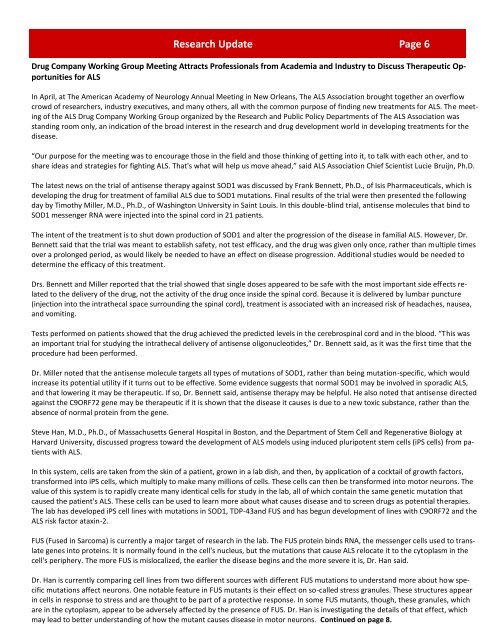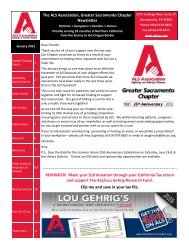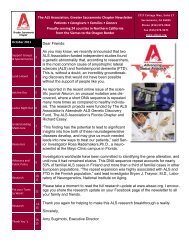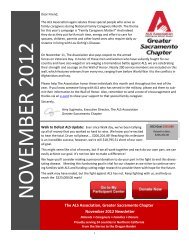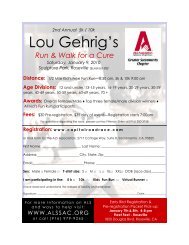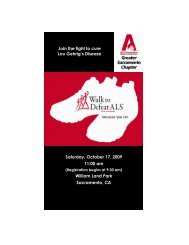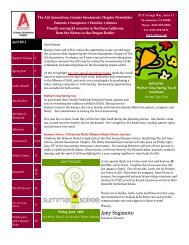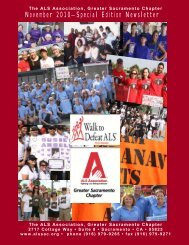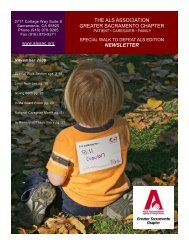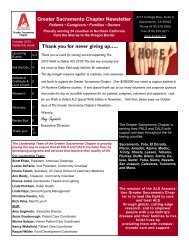June 2012 - The ALS Association Greater Sacramento
June 2012 - The ALS Association Greater Sacramento
June 2012 - The ALS Association Greater Sacramento
You also want an ePaper? Increase the reach of your titles
YUMPU automatically turns print PDFs into web optimized ePapers that Google loves.
Research Update<br />
Page 6<br />
Drug Company Working Group Meeting Attracts Professionals from Academia and Industry to Discuss <strong>The</strong>rapeutic Opportunities<br />
for <strong>ALS</strong><br />
In April, at <strong>The</strong> American Academy of Neurology Annual Meeting in New Orleans, <strong>The</strong> <strong>ALS</strong> <strong>Association</strong> brought together an overflow<br />
crowd of researchers, industry executives, and many others, all with the common purpose of finding new treatments for <strong>ALS</strong>. <strong>The</strong> meeting<br />
of the <strong>ALS</strong> Drug Company Working Group organized by the Research and Public Policy Departments of <strong>The</strong> <strong>ALS</strong> <strong>Association</strong> was<br />
standing room only, an indication of the broad interest in the research and drug development world in developing treatments for the<br />
disease.<br />
“Our purpose for the meeting was to encourage those in the field and those thinking of getting into it, to talk with each other, and to<br />
share ideas and strategies for fighting <strong>ALS</strong>. That's what will help us move ahead,” said <strong>ALS</strong> <strong>Association</strong> Chief Scientist Lucie Bruijn, Ph.D.<br />
<strong>The</strong> latest news on the trial of antisense therapy against SOD1 was discussed by Frank Bennett, Ph.D., of Isis Pharmaceuticals, which is<br />
developing the drug for treatment of familial <strong>ALS</strong> due to SOD1 mutations. Final results of the trial were then presented the following<br />
day by Timothy Miller, M.D., Ph.D., of Washington University in Saint Louis. In this double-blind trial, antisense molecules that bind to<br />
SOD1 messenger RNA were injected into the spinal cord in 21 patients.<br />
<strong>The</strong> intent of the treatment is to shut down production of SOD1 and alter the progression of the disease in familial <strong>ALS</strong>. However, Dr.<br />
Bennett said that the trial was meant to establish safety, not test efficacy, and the drug was given only once, rather than multiple times<br />
over a prolonged period, as would likely be needed to have an effect on disease progression. Additional studies would be needed to<br />
determine the efficacy of this treatment.<br />
Drs. Bennett and Miller reported that the trial showed that single doses appeared to be safe with the most important side effects related<br />
to the delivery of the drug, not the activity of the drug once inside the spinal cord. Because it is delivered by lumbar puncture<br />
(injection into the intrathecal space surrounding the spinal cord), treatment is associated with an increased risk of headaches, nausea,<br />
and vomiting.<br />
Tests performed on patients showed that the drug achieved the predicted levels in the cerebrospinal cord and in the blood. “This was<br />
an important trial for studying the intrathecal delivery of antisense oligonucleotides,” Dr. Bennett said, as it was the first time that the<br />
procedure had been performed.<br />
Dr. Miller noted that the antisense molecule targets all types of mutations of SOD1, rather than being mutation-specific, which would<br />
increase its potential utility if it turns out to be effective. Some evidence suggests that normal SOD1 may be involved in sporadic <strong>ALS</strong>,<br />
and that lowering it may be therapeutic. If so, Dr. Bennett said, antisense therapy may be helpful. He also noted that antisense directed<br />
against the C9ORF72 gene may be therapeutic if it is shown that the disease it causes is due to a new toxic substance, rather than the<br />
absence of normal protein from the gene.<br />
Steve Han, M.D., Ph.D., of Massachusetts General Hospital in Boston, and the Department of Stem Cell and Regenerative Biology at<br />
Harvard University, discussed progress toward the development of <strong>ALS</strong> models using induced pluripotent stem cells (iPS cells) from patients<br />
with <strong>ALS</strong>.<br />
In this system, cells are taken from the skin of a patient, grown in a lab dish, and then, by application of a cocktail of growth factors,<br />
transformed into iPS cells, which multiply to make many millions of cells. <strong>The</strong>se cells can then be transformed into motor neurons. <strong>The</strong><br />
value of this system is to rapidly create many identical cells for study in the lab, all of which contain the same genetic mutation that<br />
caused the patient's <strong>ALS</strong>. <strong>The</strong>se cells can be used to learn more about what causes disease and to screen drugs as potential therapies.<br />
<strong>The</strong> lab has developed iPS cell lines with mutations in SOD1, TDP-43and FUS and has begun development of lines with C9ORF72 and the<br />
<strong>ALS</strong> risk factor ataxin-2.<br />
FUS (Fused in Sarcoma) is currently a major target of research in the lab. <strong>The</strong> FUS protein binds RNA, the messenger cells used to translate<br />
genes into proteins. It is normally found in the cell's nucleus, but the mutations that cause <strong>ALS</strong> relocate it to the cytoplasm in the<br />
cell's periphery. <strong>The</strong> more FUS is mislocalized, the earlier the disease begins and the more severe it is, Dr. Han said.<br />
Dr. Han is currently comparing cell lines from two different sources with different FUS mutations to understand more about how specific<br />
mutations affect neurons. One notable feature in FUS mutants is their effect on so-called stress granules. <strong>The</strong>se structures appear<br />
in cells in response to stress and are thought to be part of a protective response. In some FUS mutants, though, these granules, which<br />
are in the cytoplasm, appear to be adversely affected by the presence of FUS. Dr. Han is investigating the details of that effect, which<br />
may lead to better understanding of how the mutant causes disease in motor neurons. Continued on page 8.


